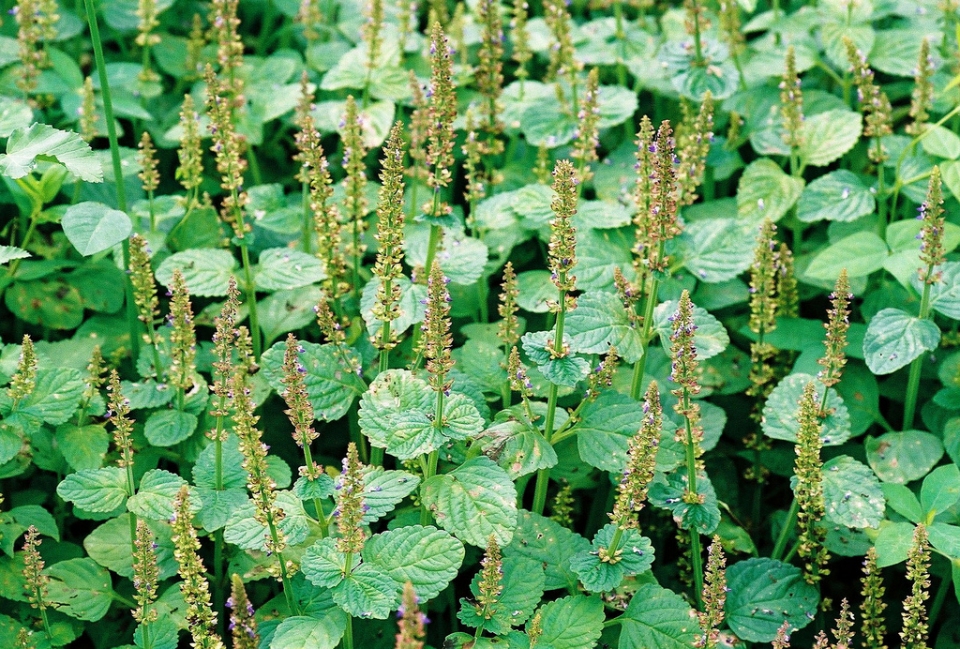Solenostemon monostachyus

|
|
Solenostemon monostachyus Common Names: Monkey potato, catnip Scientific
Classification Kingdom: Plantae Phylum: Magnoliophyta Class: Angiospermae Order: Lamiales Family: Lamiaceae Genus: Solenostemon Species: S. monostachyus Authority: (Palisot
de Beauvois) Briquet Synonyms: Plectranthus
monostachyus, Coleus monostachyus Morphological Description Solenostemon monostachyus, commonly known as monkey potato, is an aromatic herbaceous plant
that can grow as an annual or short-lived perennial, typically reaching heights
of 30–100 cm, though occasionally up to 150 cm in optimal conditions (Useful
Tropical Plants, 2024). The stems are succulent, quadrangular, and slightly
hairy, becoming woody at the base in perennial forms. The leaves are light
green, broadly ovate to egg-shaped, measuring 4–12 cm long and 2–8 cm wide,
with rounded, crenate (toothed) margins and a soft, velvety texture due to fine
pubescence (Lemmens, 2004). The plant produces terminal or axillary
inflorescences composed of small, two-lipped flowers, 5–8 mm long, with a
purple to lilac corolla and white throat, borne in dense, spike-like clusters
(Okokon et al., 2016). The fruit consists of small, ovoid nutlets, 1–2 mm in
diameter, enclosed in a persistent calyx, contributing to its dispersal by wind
or animals. Distribution and Habitat Solenostemon monostachyus is native to West and Central Africa, spanning countries
such as Nigeria, Cameroon, Ghana, and Côte d'Ivoire, and has been introduced to
parts of Costa Rica as an invasive weed (EPPO Global Database, 2024;
Retana-Sánchez et al., 2013). It thrives in tropical climates with annual
rainfall of 800–2,000 mm and temperatures of 20–35°C, commonly occurring in
disturbed habitats like roadsides, gardens, cultivated fields, and rocky
savannahs (Lemmens, 2004). The plant prefers well-drained, loamy or sandy soils
with a pH range of 5.0–7.5 and can tolerate partial shade to full sun,
showcasing its ecological versatility (Useful Tropical Plants, 2024). Its
adaptability has led to its proliferation in anthropogenic landscapes, where it
often emerges as a pioneer species. Ethnopharmacology Solenostemon monostachyus is deeply embedded in West African traditional medicine,
valued for its antioxidant, anti-inflammatory, and analgesic properties,
attributed to bioactive compounds like steroidal saponins, alkaloids,
flavonoids, and phenolic acids (Chen et al., 2022; Okokon et al., 2016). Below
are key ethnopharmacological uses supported by research: · Anti-inflammatory and Analgesic: In Nigeria, aerial parts are decocted to
treat inflammation, pain, and ulcers. Ethanol extracts (75–225 mg/kg) reduced carrageenan-induced
edema in mice by up to 60% and acetic acid-induced writhing by 45%, comparable
to aspirin (100 mg/kg), suggesting central and peripheral mechanisms (Okokon et
al., 2016). · Antisickling for Sickle Cell Anemia: Leaves are used in southern Nigeria to
manage sickle cell disease. Methanolic extracts significantly reduced sickle
cell polymerization in vitro (P < 0.05) and increased hemoglobin levels in
female sickle cell blood compared to controls, linked to antioxidant effects
(Imaga et al., 2013). · Antimalarial and Antipyretic: Decoctions treat fever and malaria among
the Ibibio people. The extract (225 mg/kg) suppressed Plasmodium berghei parasitemia by 68% in mice and reduced
yeast-induced pyrexia, supporting its folkloric use (Okokon et al., 2017). · Neuroprotective Effects: Used traditionally for CNS conditions like
convulsions, studies show leaf extracts suppress CNS activity in rats, possibly
via GABAergic pathways, with mild sedative effects at 150 mg/kg (Omoloye et
al., 2015). Phytochemical analyses
reveal diterpenoids, essential oils, and polyphenols, enhancing its therapeutic
potential (Okokon et al., 2016; Chen et al., 2022). ⚠ Toxicity Profile: While Solenostemon
monostachyus is generally safe
in traditional doses, excessive consumption may lead to toxicity due to
alkaloids and saponins. Acute toxicity studies in rats showed no mortality up
to 25,000 mg/kg, but doses above 1,000 mg/kg caused gastrointestinal distress
(nausea, vomiting) and sedation (Omoloye et al., 2015). Prolonged use may
elevate liver enzymes (ALT up by 20% at 250 mg/kg), indicating potential
hepatotoxicity (Afolabi et al., 2017). Use under medical supervision is
recommended. Additional Uses · Nutritional Value: Leaves contain 4.3 g protein, 10.4 g
carbohydrates, 437 mg calcium, and 109 mg phosphorus per 100 g, offering 55
kcal, making it a minor vegetable in some regions (Lemmens, 2004). · Agricultural Role: Its invasiveness in Costa Rica suggests
potential as a cover crop, though it competes with pineapple and banana
plantations ( Brenes-Prendas et
al., 2013). · Ritual Use: In West Africa, it’s used in pregnancy-related rituals,
symbolizing protection and fertility (Lemmens, 2004). References
External Links More Pictures |
|
| Compounds of Solenostemon monostachyus | |
| References |